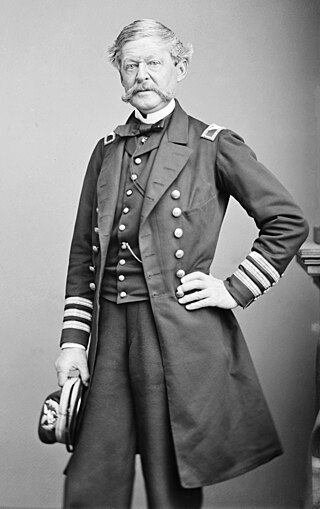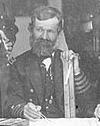
USS Vincennes was a 703-ton Boston-class sloop of war in the United States Navy from 1826 to 1865. During her service, Vincennes patrolled the Pacific, explored the Antarctic, and blockaded the Confederate Gulf coast in the Civil War. Named for the Revolutionary War Battle of Vincennes, she was the first U.S. warship to circumnavigate the globe.

Charles Wilkes was an American naval officer, ship's captain, and explorer. He led the United States Exploring Expedition (1838–1842).

Daniel Ammen was a U.S. naval officer during the American Civil War and the Reconstruction era, as well as a prolific author. His last assignment in the Navy was Chief of the Bureau of Navigation.

The second USS Porpoise was a 224-ton Dolphin-class brigantine. Porpoise was later re-rigged as a brig. She was based on the same plans as Dolphin.

The Pacific Squadron was part of the United States Navy squadron stationed in the Pacific Ocean in the 19th and early 20th centuries. Initially with no United States ports in the Pacific, they operated out of storeships which provided naval supplies and purchased food and obtained water from local ports of call in the Hawaiian Islands and towns on the Pacific Coast. Throughout the history of the Pacific Squadron, American ships fought against several enemies. Over one-half of the United States Navy would be sent to join the Pacific Squadron during the Mexican–American War. During the American Civil War, the squadron was reduced in size when its vessels were reassigned to Atlantic duty. When the Civil War was over, the squadron was reinforced again until being disbanded just after the turn of the 20th century.

The United States Exploring Expedition of 1838–1842 was an exploring and surveying expedition of the Pacific Ocean and surrounding lands conducted by the United States. The original appointed commanding officer was Commodore Thomas ap Catesby Jones. Funding for the original expedition was requested by President John Quincy Adams in 1828; however, Congress would not implement funding until eight years later. In May 1836, the oceanic exploration voyage was finally authorized by Congress and created by President Andrew Jackson.
The first USS Relief was a supply ship in the United States Navy.

USS Peacock was a sloop-of-war in the United States Navy during the War of 1812.
USS John Hancock was an armed steam tug in the United States Navy during the 1850s. She was named for Founding Father John Hancock and saw action against rioters in Massachusetts, filbusters in Cuba, rebels in China, and Native Americans in the Washington Territory. She took part in a hydrographic surveying expedition to East Asia and the Pacific Ocean.

The East India Squadron, or East Indies Squadron, was a squadron of American ships that existed in the nineteenth century. It focused on protecting American interests in the Far East, while the Pacific Squadron concentrated on the western coasts of the Americas and the South Pacific Ocean. Its duties included the Yangtze River Patrol in China. The East India Squadron was established in 1835 and existed until it became part of the Asiatic Squadron in 1868.

The North Pacific Exploring and Surveying Expedition, also known as the Rodgers-Ringgold Expedition was a United States scientific and exploring project from 1853 to 1856.

USS Sea Gull was a schooner in the service of the United States Navy. The Sea Gull was one of six ships that sailed in the US Exploring Expedition in 1838 to survey the coast of the then-unknown continent of Antarctica and the Pacific Islands. The specimens collected on the voyage would later form the backbone of the Smithsonian Institution.
USS Fenimore Cooper was a United States Navy schooner assigned as a ship’s tender to accompany a surveying expedition. After departing from Hampton Roads, Virginia, and navigating the Cape of Good Hope, the expedition traveled throughout the Pacific Ocean accumulating hydrographic information from the South China Sea to the Bering Strait in the Arctic and Alaska.
USS Oregon was a brig that served in the United States Navy from 1841 to 1845.
USS Boxer of the United States Navy was a 10-gun schooner, launched on 22 November 1831 by the Boston Navy Yard, and commissioned sometime in 1832, with Lt. Benjamin Payne in command; this was the second U.S. Navy ship to be named for the original HMS Boxer, which had been captured from the British during the War of 1812.

Cadwalader Ringgold was an officer in the United States Navy who served in the United States Exploring Expedition, later headed an expedition to the Northwest and, after initially retiring, returned to service during the Civil War.

The era of European and American voyages of scientific exploration followed the Age of Discovery and were inspired by a new confidence in science and reason that arose in the Age of Enlightenment. Maritime expeditions in the Age of Discovery were a means of expanding colonial empires, establishing new trade routes and extending diplomatic and trade relations to new territories, but with the Enlightenment scientific curiosity became a new motive for exploration to add to the commercial and political ambitions of the past. See also List of Arctic expeditions and List of Antarctic expeditions.
Matthew Brisbane was a Scottish mariner, sealer and notable figure in the early history of the Falkland Islands.

Rear Admiral George Henry Cooper was an officer in the United States Navy. During his long naval career, he served on the African Slave Trade Patrol, and fought in the Second Seminole War, the Mexican War, the American Civil War, and the Korean Expedition, and rose to command of the North Atlantic Squadron.

William Edgar Le Roy was an officer in the United States Navy who served in the Mexican War, on the African Slave Trade Patrol, and in the American Civil War. He rose to the rank of rear admiral and late in his career was consecutively commander-in-chief of the South Atlantic Squadron, the North Atlantic Squadron, and the European Squadron.














